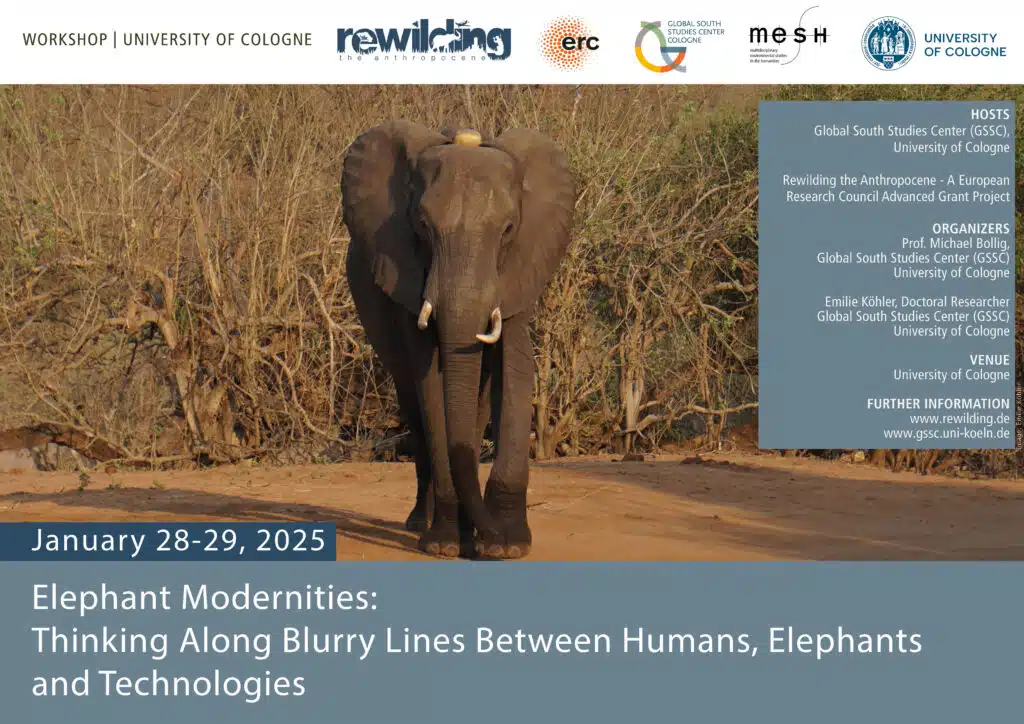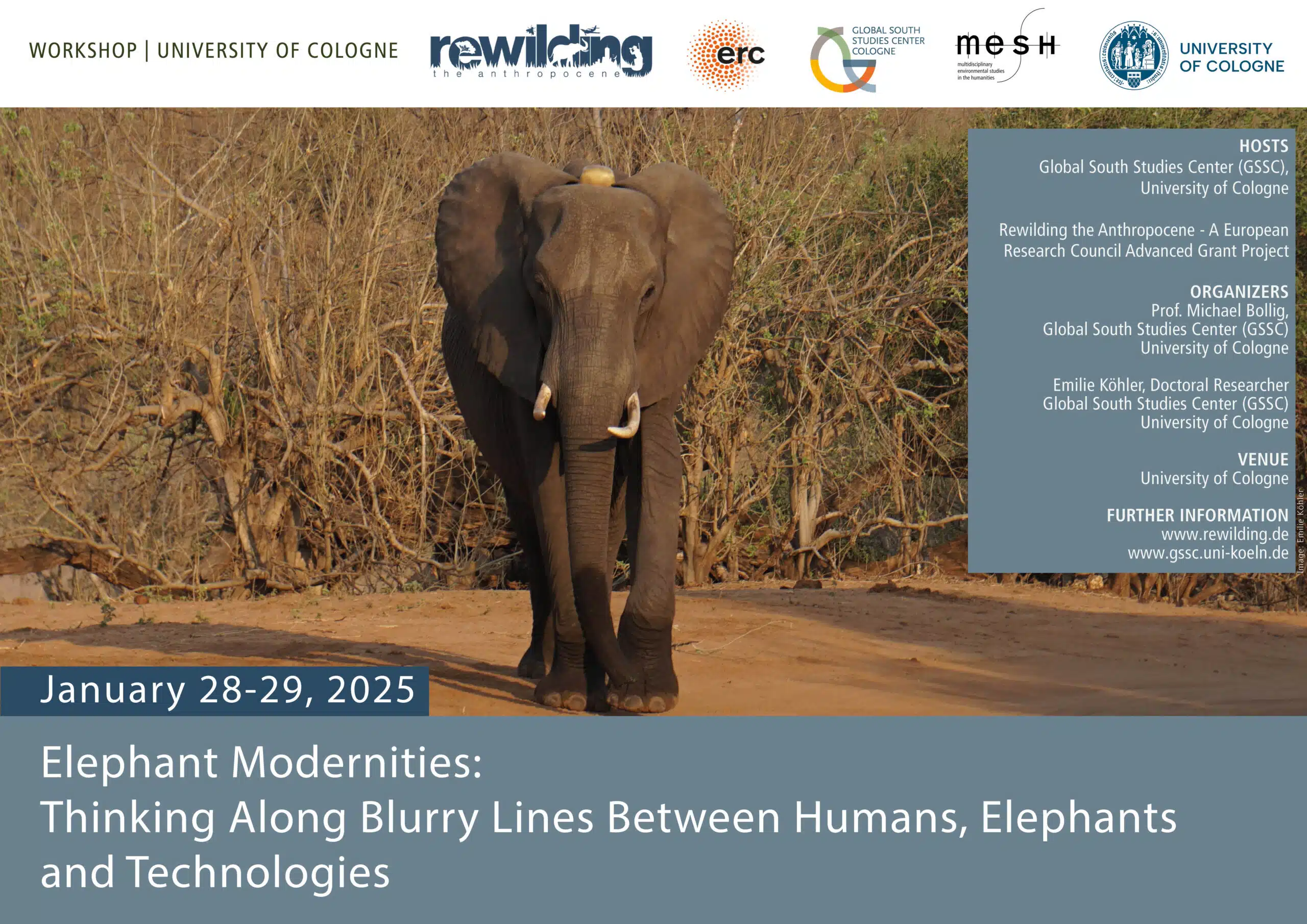Workshop: Elephant Modernities – Thinking Along Blurry Lines Between Humans, Elephants and Technologies
This two-day workshop is dedicated to the topic of elephant modernities and invites experts to discuss and explore the lifeworlds of African elephants (Loxodonta Africana) in the Anthropocene. The concept of “elephant modernity,” coined by “Sharing a Planet in Peril” (SAPP) member Dan Smyer Yü, describes the profound changes in the lives and habitats of elephants in the contemporary era, largely shaped by human activities.
This transformation encompasses various elements such as habitat loss, dwindling elephant populations, the disappearance of transitional habitats, growing reliance on humans, and the commercialization of elephants for tourism (Yü 2023). Elephants, with their advanced cognitive and emotional abilities, self-awareness, and capacity to adapt to human environments, challenge traditional distinctions between nature and culture, as well as between humans and non-human beings (Locke 2013; Lorimer 2015). Accelerated by technological advancements, human population growth, and environmental shifts, the spheres of human and elephant existence increasingly overlap. Elephants have become global symbols of wildlife, objects of desire, and commodities, as their lives become entwined with the principles of neoliberal capitalism (Barua 2014; Duffy 2014; Nance 2015). The majestic herbivores face numerous challenges under human dominion, including captivity-induced distress, post-traumatic stress disorder resulting from culls or conflicts, and the constant threats of poaching and habitat loss. Nonetheless, the clever pachyderms also find manifold ways to adapt to modernity: They are able to sniff out landmines, benefit from human food sources and use modern infrastructure to get water (see for example Miller et al. 2015; Garstang 2015).
To further the discussion on elephant modernities, this workshop also takes into consideration how the omnipresence of technology in contemporary life has deeply intertwined with the worlds of elephants. Monitoring tools like GPS collars and camera traps offer intimate insights into elephant behavior, and make the proboscideans co-creators of envisioned multispecies landscapes through the data they generate. Concurrently, their agile trunks serve as inspiration for the design of robotic technologies. Departing from an understanding that elephants are historical, social, and ecological beings, crossing boundaries of human order, this workshop aims to enhance interdisciplinary dialogue to explore the versatile aspects that constitute elephant modernities in the Anthropocene. Contributions will be structured around three main topics and mainly focus on the African elephant, who has received less attention in the humanities and social sciences to date: First, we will focus on elephants and technologies, exploring beneficial and harmful entanglements between elephants, technologies, and humans. Interdisciplinary contributions will focus on the use, impact, and effects of technologies in elephant conservation, but also how elephants contribute to data production, technological developments, and become part of a digital world. Second, we will explore environmental changes and how elephants co-adapt to anthropogenic landscapes. Elephants are confined to designated national parks, cross fences, roads, and settlements, feed on cultivated crops, and break water pipelines. Humans, in turn, put up road signs, designate corridors or drill boreholes to steer elephant movements. Here, we aim to understand how elephants live in and co-shape anthropogenic landscapes. Third, we will focus on elephant cultures. Elephants are known to be socially complex, smart, and emotional animals whose cultures are yet to be fully understood but experience rapid change (Poole and Moss 2008). Trophy hunters impact elephant social structures by shooting mainly old bulls, elephant culls and war leave deep, long-lasting emotional traumas in elephant societies, and new generations of elephants get raised in sanctuaries or zoos where they develop “bicultural” identities (Bradshaw 2009; Stoeger et al. 2012). In this part, we will discuss changes in elephant cultures and how a better understanding thereof can enable new ways of coexistence.
Please submit an abstract before the 1st of September 2024.
Hosts
Global South Studies Center (GSSC), the University of Cologne
Rewilding the Anthropocene – A European Research Council Advanced Grant Project
Organizers
Prof. Michael Bollig, Global South Studies Center, University of Cologne
michael.bollig@uni-koeln.de
Emilie Köhler, Doctoral Researcher, Global South Studies Center, University of Cologne
emilie.koehler@uni-koeln.de
Venue
University of Cologne, Germany
Date
28-29 January 2025
References
Barua, Maan. 2014. “Circulating Elephants: Unpacking the Geographies of a Cosmopolitan Animal.”
Transactions of the Institute of British Geographers 39 (4): 559–73. DOI
Bradshaw, Gay. 2009. Elephants on the Edge: What Animals Teach Us about Humanity. New Haven:
Yale University Press.
Duffy, Rosaleen. 2014. “Interactive Elephants: Nature, Tourism and Neoliberalism.” Annals of Tourism
Research 44 (January): 88–101. DOI
Garstang, Michael. 2015. “Introduction.” In Elephant Sense and Sensibility, 1–4. Elsevier. DOI
Locke, Piers. 2013. “Explorations in Ethnoelephantology: Social, Historical, and Ecological Intersections
between Asian Elephants and Humans.” Environment and Society 4 (1). DOI
Lorimer, Jamie. 2015. Wildlife in the Anthropocene: Conservation after Nature. University of Minnesota
Press. Link
Miller, Ashadee, Michael Hensman, Sean Hensman, Kip Schultz, Paul Reid, Mike Shore, Jessica Brown,
Kenneth Furton, and Stephen Lee. 2015. “African Elephants (Loxodonta Africana) Can Detect TNT Using
Olfaction: Implications for Biosensor Application.” Applied Animal Behaviour Science, August. DOI
Nance, Susan. 2015. “Introduction: Modernity for Animals?” In Animal Modernity: Jumbo the Elephant
and the Human Dilemma, by Susan Nance, 1–8. London: Palgrave Macmillan UK.
https://doi.org/10.1007/978-1-137-56207-4_1.
Poole, Joyce, and Cynthia Moss. 2008. “Elephant Sociality and Complexity.” In Elephants and Ethics,
edited by Christen Wemmer, 69–98. Johns Hopkins University Press. DOI
Stoeger, Angela S., Daniel Mietchen, Sukhun Oh, Shermin de Silva, Christian T. Herbst, Soowhan Kwon,
and W. Tecumseh Fitch. 2012. “An Asian Elephant Imitates Human Speech.” Current Biology 22 (22):
2144–48. DOI
Yü, Dan Smyer. 2023. “Collapsing Elephant Clime Since the Little Ice Age.” In Storying Multipolar Climes
of the Himalaya, Andes and Arctic, by Dan Smyer Yü and Jelle J.P. Wouters, 1st ed., 236–52. London:
Routledge. DOI



